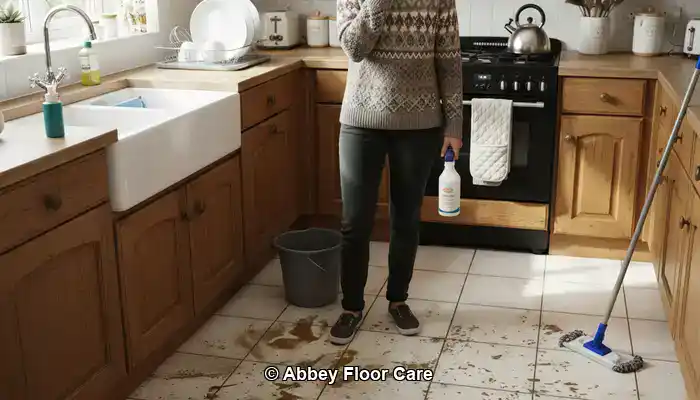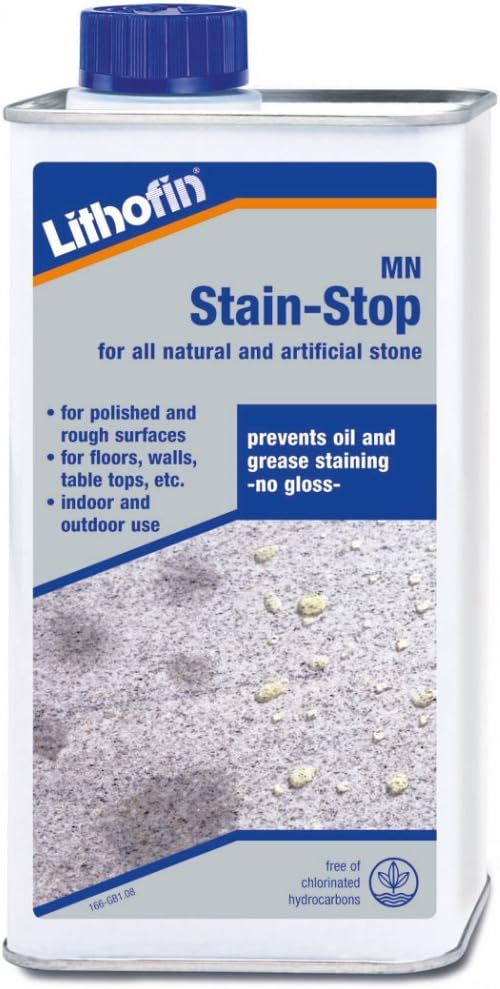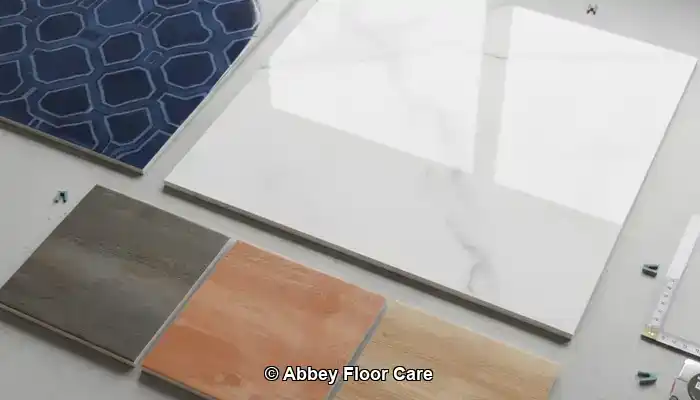
How Often Should You Reseal Porcelain Tiles
Last Updated on November 8, 2025 by David
Key takeaways from the article: How Often Should You Reseal Porcelain Tiles
- Porcelain tiles may not always need surface sealing, but grout lines should be resealed every 1 to 2 years to prevent staining and moisture absorption.
- High-traffic areas like kitchens and hallways require more frequent resealing than low-traffic rooms like guest bathrooms.
- The water drop test is a simple way to check if resealing is needed—if water absorbs into the tile or grout, it’s time to reseal.
- Choosing the right sealer depends on tile type and location; penetrating sealers are best for unglazed porcelain and grout.
- Over-sealing, using harsh cleaners, or skipping grout lines are common mistakes that reduce the effectiveness of resealing and may damage the floor.
Understanding Porcelain Tile Types
Pro Tip: We recommend these products for daily Grout maintenance cleaning.

Fila Pro Floor Cleaner
|

Lithofin MN Stain Stop
|

Vileda H2PrO Spin Mop System
|

Glazed vs Unglazed Porcelain
Porcelain tiles come in two main finishes: glazed and unglazed. Glazed porcelain has a protective coating baked onto the surface, offering enhanced stain resistance and a wider range of visual effects. Unglazed porcelain, on the other hand, has a more natural, matte appearance and is often chosen for its slip resistance and durability in high-traffic areas. While glazed tiles may not always require sealing, unglazed tiles are more porous and benefit from periodic resealing to prevent moisture absorption and staining.
Ceramic vs Porcelain Differences
Though often confused, ceramic and porcelain tiles differ in density, water absorption, and durability. Porcelain is fired at higher temperatures, making it denser and less porous than ceramic. This makes porcelain better suited for areas with frequent moisture exposure, such as kitchens and bathrooms. Understanding this distinction helps homeowners choose appropriate sealing schedules and cleaning products.
Why Porcelain Is Popular in UK Homes
Porcelain tiles are widely used in UK homes due to their low maintenance, aesthetic versatility, and compatibility with underfloor heating. Their ability to mimic natural stone or wood while offering superior durability makes them a practical choice for both modern and traditional interiors. Homeowners value porcelain for its long-term performance, especially when paired with proper sealing and care routines.
 Why Resealing Matters for Long-Term Care
Why Resealing Matters for Long-Term Care
Grout vs Tile Surface Needs
Porcelain tiles are often low-porosity, mainly when glazed, but grout lines are highly absorbent and prone to staining. While the tile surface may resist moisture, the grout between tiles can absorb spills, dirt, and cleaning products. Resealing helps create a barrier that protects grout from discolouration and erosion, especially in kitchens and bathrooms where exposure is frequent.
Moisture Resistance and Stain Prevention
Resealing enhances moisture resistance and reduces the risk of stains penetrating porous areas. In high-traffic areas like hallways and utility rooms, resealing helps maintain the floor’s appearance and prevents long-term damage. Homeowners who reseal regularly extend the lifespan of both the tile and the grout, especially in areas exposed to water or cleaning agents.
Preserving Appearance and Slip Resistance
Over time, unsealed or poorly sealed tiles can lose their original finish, appearing dull or uneven. Resealing helps preserve the surface sheen and can improve slip resistance when the correct product is used. This is particularly important in bathrooms and entryways, where wet conditions increase the risk of slips. A well-maintained seal supports both safety and aesthetics.
Factors That Influence Resealing Frequency

Impact of Foot Traffic and Room Use
Areas with heavy foot traffic, such as hallways and kitchens, tend to wear faster and expose grout to more dirt and moisture. In contrast, low-traffic rooms like guest bathrooms or spare bedrooms may require resealing less often. Homeowners should assess each room individually rather than applying a one-size-fits-all schedule.
Cleaning Products and Surface Wear
Using harsh or acidic cleaners can prematurely degrade sealers, especially in grout lines. Even tile-safe products can strip protective layers if used too frequently or diluted too much. A gentle, pH-neutral cleaner helps preserve the seal and reduce the need for early resealing.
Indoor Climate and Ventilation
Humidity levels and airflow affect how quickly grout and tile surfaces dry after cleaning. Poor ventilation can lead to prolonged moisture exposure, which may weaken sealers over time. Well-ventilated homes with balanced humidity tend to maintain sealed surfaces longer, especially in bathrooms and utility areas.
Need help with your tiles? Send us a quick message and we’ll get back to you with practical advice.
How to Check If Your Tiles Need Resealing
Signs of Wear or Absorption
Visible changes in grout colour, increased staining, or a dull tile surface may indicate that the seal has worn off. In high-use areas, this can happen gradually, making it easy to overlook until dirt becomes harder to remove or moisture begins to linger after cleaning.
Water Drop Test Explained
A straightforward way to check for seal failure is the water drop test. Place a few drops of water on the tile and grout, then observe whether they bead up or soak in. If the water absorbs quickly or leaves a dark patch, it’s time to reseal. This test works best on unglazed porcelain and grout lines, where porosity is higher.
Surface Dullness and Grout Discolouration
Tiles that appear chalky or uneven in sheen may have lost their protective layer. Similarly, grout that darkens or shows patchy staining is often a sign that the seal has broken down. These visual cues help homeowners decide whether resealing is needed, even if the floor still feels clean.
Choosing the Right Sealer for Porcelain Floors
Penetrating vs Surface Sealers
Penetrating sealers absorb into the tile and grout, creating a protective barrier without altering the surface appearance. They’re ideal for unglazed porcelain and grout lines, offering moisture resistance while maintaining a natural finish. Surface sealers, on the other hand, form a visible layer and may add sheen or texture. These are more common on decorative tiles, but can affect slip resistance if not chosen carefully.
Tile-Safe and Grout-Safe Options
Not all sealers are suitable for both tile and grout. Homeowners should look for products specifically labelled as safe for porcelain and compatible with cement-based grout. Using the wrong type can lead to hazing, residue buildup, or reduced effectiveness. Reading product labels and checking for UK safety standards helps ensure long-term performance.
Eco-Friendly and Pet-Safe Products
Many modern sealers are water-based and low in volatile organic compounds (VOCs), making them safer for indoor use. For homes with pets or children, choosing a non-toxic, eco-friendly sealer reduces exposure risks during application and drying. These products also tend to have shorter ventilation requirements and are easier to clean up.
Step-by-Step Resealing Process
Surface Prep and Cleaning
Before resealing, the tile and grout must be thoroughly cleaned using a pH-neutral cleaner. Remove all surface dirt, oils, and residues to ensure the sealer bonds properly. Allow the floor to dry completely, as moisture trapped beneath the sealer can lead to hazing or uneven coverage.
Application Tools and Techniques
Use a soft applicator pad, microfibre cloth, or brush, depending on the product and surface type. Apply the sealer evenly across the tile and grout, working in manageable sections to avoid overlap marks. Follow the manufacturer’s instructions for coverage rates and avoid pooling excess product in grout joints.
Drying Times and Ventilation Tips
Most sealers require a drying period of 2 to 4 hours before light foot traffic and up to 24 hours for complete curing. Open windows or use fans to improve airflow, especially in enclosed rooms. Avoid wet cleaning or placing rugs on the surface until the seal has fully cured to prevent imprinting or tackiness.
Resealing Timelines for Different Rooms
Kitchen vs Bathroom vs Hallway
Kitchens often require resealing every 12 to 18 months due to frequent spills, cooking residue, and foot traffic. Bathrooms may follow a similar schedule, especially around showers and sinks where moisture exposure is high. Hallways, depending on usage, may need resealing every 18 to 24 months to maintain grout protection and surface clarity.
Low-Traffic vs High-Traffic Areas
In low-traffic rooms like guest bathrooms or spare bedrooms, resealing every 2 to 3 years may be sufficient. High-traffic zones such as entryways, kitchens, and utility rooms benefit from more frequent attention. Homeowners should adjust their resealing schedule based on how each space is used rather than relying on a fixed timeline.
Seasonal Considerations
Spring and early autumn are ideal times to reseal floors in the UK, as they offer moderate temperatures and good ventilation. Avoid resealing during periods of high humidity or extreme cold, as these conditions can affect drying times and product performance. Planning resealing around seasonal cleaning routines helps maintain consistency and floor health.
Common Mistakes to Avoid
Over-sealing Risks
Applying too much sealer or resealing too frequently can lead to surface buildup, hazing, or sticky residue. This is especially true with surface sealers that form a visible layer. Homeowners should follow manufacturer guidelines and avoid resealing unless the previous layer has worn down or failed.
Using Harsh Cleaners Before Sealing
Acidic or bleach-based cleaners can compromise the tile and grout, making it harder for the sealer to bond correctly. Always clean with a pH-neutral product before resealing to ensure the surface is safe and ready for treatment. Harsh chemicals may also leave residues that interfere with sealer performance.
Skipping Grout Lines
Grout is often the most vulnerable part of a tiled floor, yet it’s easy to overlook during resealing. Skipping grout lines can lead to uneven protection and faster staining. Use a small brush or targeted applicator to ensure grout receives full coverage, especially in kitchens and bathrooms.
FAQs About Porcelain Tile Resealing
Can I reseal tiles myself?
Yes, many homeowners choose to reseal their porcelain tiles and grout themselves using off-the-shelf products. The key is to follow instructions carefully, use tile-safe sealers, and ensure the surface is clean and dry before application. DIY resealing is most effective in low-traffic areas or for routine maintenance.
How do I test for seal failure?
The water drop test is a reliable method. Place a few drops of water on the tile and grout, then observe whether they bead or soak in. If the water absorbs quickly or leaves a dark patch, the seal is likely compromised, and resealing is recommended.
What products are safe for pets?
Look for water-based sealers with low VOC content and labels indicating non-toxic or pet-safe certification. These products reduce exposure risks during application and drying, making them suitable for homes with pets or children. Always ventilate the area well and keep pets off the floor until the seal has cured.
Is resealing needed for glazed tiles?
Glazed porcelain tiles typically do not require surface sealing, but the grout between them still benefits from regular resealing. In some cases, a light application of penetrating sealer may be used to protect the grout without affecting the tile’s finish.
Recent Posts:
We work throughout the country, just some of our work counties:
Copyright © 2025 Abbey Floor Care. Tile And Natural Stone Cleaning Consultants FAQ - Privacy Policy - Terms And Conditions
Abbey Floor Care is a participant in the Amazon Services LLC Associates Programme, an affiliate advertising programme designed to provide a means for websites to earn advertising fees by linking to Amazon.co.uk. As an Amazon Associate, we earn from qualifying purchases.